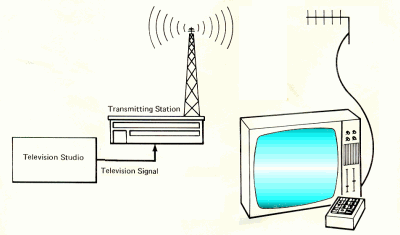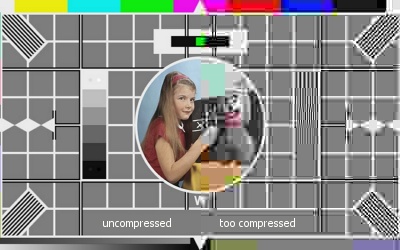Do I need to buy a booster?
 Brian Butterworth published on UK Free TV
Brian Butterworth published on UK Free TV With analogue television, it has often been necessary to buy an amplifier to improve the quality of the television picture, or to supply a steady on several televisions fed from the same aerial.
Many people have asked if it necessary to investing in a signal booster for Freeview.
"Analogue television" means is that the sound and pictures are broadcast using signals that are an "analogue" of the input. The sound and picture are transmitted from the source as electrical signals, then as radio waves and then back to sound and picture again.
In an analogue television camera, the image is scanned 25 times a second from side to side, from top to bottom and back. Where a lot of light is scanned, a high voltage is produced. Where no light is scanned, no voltage is produced. The output voltage is the same ratio to amount of light at scanned.
Leaving aside the technically, this signal is sent to the transmitter. The transmitter emits a radio wave on a known frequency, which is varied by the incoming voltage.

A microphone also converts the sound vibrations it picks up into a voltage, which when sent to the transmitter is added to another radio transmission frequency.
The signals are received by a television aerial pointing at the transmitter and converted back to very weak electrical signals. The sound is amplified and sent to a loudspeaker, and a picture created on the TV screen.
So on an analogue television, if the incoming signal is weak then the picture is dull as the background noise (the snow scene seen when an analogue television is not tuned) makes the picture less watchable.
The best analogue television set equipped with a great TV aerial located near to a high powered transmitter will produce brilliant pictures and clear sound. A poor set with an inadequate aerial or substandard cable will not.
If a weak signal is fed to a booster device, this will make the picture appear better on the television set or sets. It is often worth the investment.
Digital television
In a digital studio, the voltages from the cameras and microphones are not sent directly to the transmitter. It is converted into a stream of numbers inside a computer. The input voltage relates directly to the number in the computer. By sampling the input at a regular frequency, it is therefore possible to both store and transmit the information digitally this is what computers are good at.
It is therefore possible to take these numbers and generate a sound and picture output from them. However, the amount of information generated is over 240Mb/s, 30 times the rate of the fastest broadband connection.
Buy using computational techniques on this information the data can be compressed to as low as 2Mb/s, with as little as 6Mb/s being required for a good quality picture. These data compression techniques are called "lossy" because the reconstructed images are not identical to the originals, but look virtually similar to human eyes.

Digital television uses the same transmission frequencies as analogue uses, known as C21 to C68. The digital data is sent using a system called COFDM (Coded Orthogonal Frequency-Division-Multiplexing) which can carry data at a rate of 18Mb/s or 24Mb/s. Several television channels and some radio stations can be multiplexed together to produce exactly this amount of data.
At the receiver, it must be able to decode every single bit from these transmission multiplexes. A single error is impossible to correct for, so the decoder must have no errors.
Until switchover happens, the Freeview signals are being broadcast at very, very low power levels. However the COFDM system and sensitive digital equipment will, as long as the signal can be found and decoded there will be pixel-perfect reconstruction of the television channel. If the signal is drowned out by interference (especially from analogue transmissions) then no picture or sound will be output.
If the TV aerial installation you have provides you with all the Freeview channels, there is nothing to worry about.
If you are missing some channels because the signal is just too weak the best place to start is by improving the aerial, see Freeview reception - All about aerials. A bigger, higher, better designed aerial will always be the most sensible way to get perfect reception.
If you want to supply a signal to several sets, where the incoming signal is being "split" to serve several Freeview boxes, a masthead amplifier will be effective. This is because the signal is already of good quality and is being repeated for several sets.
However, if you are not getting a good signal from your aerial, a booster by the TV set will probably not help as this will simply boost the background interference as much as the Freeview signal.
In circumstances where an amplifier that has improved a picture on an analogue, it may be unsuitable for Freeview reception. Sometimes they will block one or more multiplex, where disconnecting the amplifier will restore the channels.
11:56 PM
Mike Stevens : As you have stated that reside on a houseboat, then you have to take into account whether or not its subject to slight drift in relation to where its moored, because if it is? then a Yagi 18 is not the best choice of aerial, as these high gain aerials are only that (high gain) because the aerials series of director elements effectively focus the signal on the active element of the aerial. Needless to say, any slight drift (or variation) in the boats position is likely to result in a significant drop in signal level, something which could result in intermittent picture glitching.
You would be much safer using a Log periodic aerial (e.g: Log 36) with, if necessary, a variable booster.
| link to this comment |
3:38 PM
My TV's with built in Freeview does store all of the Freeview channels but many are quite badly pixelated and suffer from audio clicking. I am using a Yagi type antenna split to a second set upstairs. Located WN86BP or 53. 32.73N X 2. 45.96W
Would I benefit from a wide band antenna
Thanks
| link to this comment |
4:07 PM
Skelmersdale
Peter Wright:
Unlikely at present. Skelmersdale is partly served by a Freeview Lite transmitter but there would be issues with interference from other transmitters operating on the same frequencies.
Can you tell us the reported signal strengths on the channels you can get and indicate if any are free from the problems you describe, please?
There are also some mobile service masts in close proximity to your location so they may be a sourv=ce of problems for you.
| link to this comment |
MikeP's: mapM's Freeview map terrainM's terrain plot wavesM's frequency data M's Freeview Detailed Coverage
11:27 AM
I have a good quality aerial with an amplifier in the loft which feeds 2 TVs. Recently reception has worsened and now I cannot get reception on either tv.
Any suggestions?
| link to this comment |
2:33 PM
Richard Lucas: If the problem is affecting both TVs then you need to check out the amplifier. Does it still have power going in to it? Do you get a signal if you bypass the amplifier by connecting the incoming feed from the aerial to the feed to one of the TVs?
| link to this comment |
10:27 AM
I have installed a Labgear HDMI splitter unit the output of which feeds an HDMI over Ethernet arrangement (Cat 6).When receiver is connected to TV HDMI input signal is perfect but on switching to terrestial TV only SD and radio channels are received - all HD channels are wiped out but reappear when Cat 6 cable feed to HDMI receiver is disconnected. Transmitter is Craignure, Isle if Mull. Currently using a log periodic loft aerial for Freeview. Suggestions how this issue might be remedied would be welcome.
Is siting of aerial an issue or is this a lead screening issue ? SD channel reception is perfect.
| link to this comment |
7:22 PM
Alexander Forsyth: That sounds a lot like the interference that can be emitted from a poorly screened HDMI cable. Does the Cat6 run alongside your aerial feed at any point? Can they be separated?
| link to this comment |
1:47 AM
I live in Bishopsworth Bristol
tv reception is poor. new tv only 13 channels available, tuned many times, from new installation.
pixilating most of the time I assume the converted church flats, only have an attic installed aerial ?
what is the answer?
| link to this comment |
11:31 AM
David Ellis:
To offer any useful answer we need you to provide a full post code for your location. There are several different transmitters around you and the post code will enable us to look at which is the most likely to give reliable reception for you.
Because of all the hills and buildings around, that makes it important to choose the best option.
| link to this comment |
12:01 AM
I need advice please
Live in Garnant ammanford and was told by TV aerial today that the trees and hills are blocking the transmitter from connecting with my Tv aerial signal so I asked him if there is another way to solve this issue he reply to me dont know.
Can anyone recommend on what to use to unblock / to get signal please let me know.
thanks
| link to this comment |